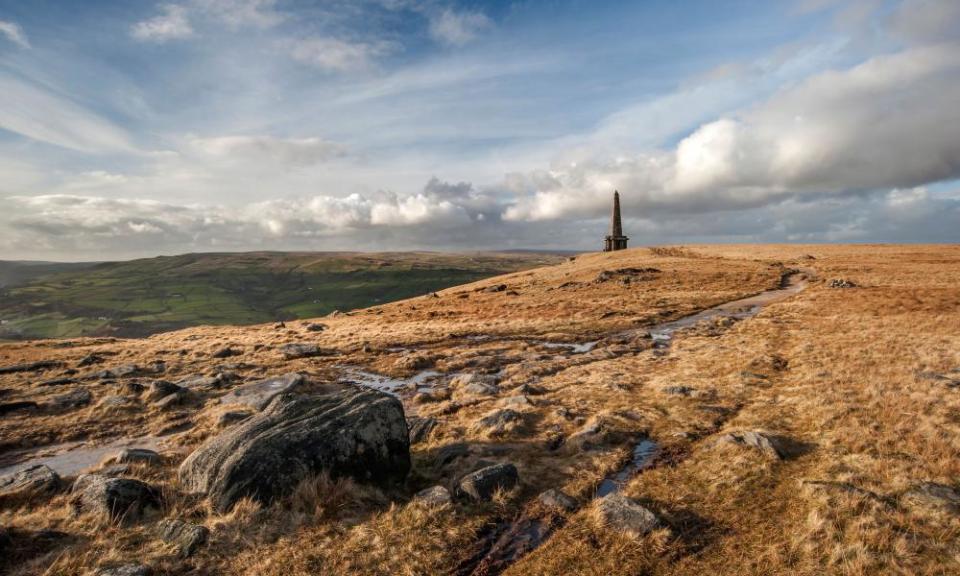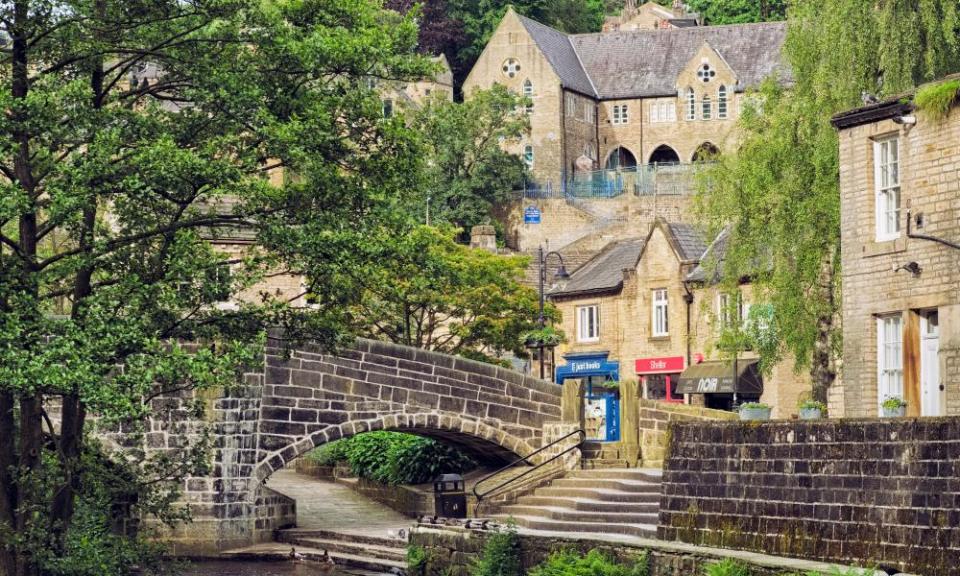Station to station: a walk in Brontë country

In 1861, civil engineer John McLandsborough paid a trip to Haworth, declaring himself a “pilgrim at the shrine of Charlotte Brontë”. The author had died six years earlier and people were curious to see where she and her sisters had been born, raised and so profoundly inspired. McLandsborough was astonished to find there was no railway line so, although he was a specialist in sewers and drains, he proposed a branch line connecting Haworth with the Midland Railway at Keighley. Six years later, a line was opened through the beautiful Worth Valley.
The line closed in 1961, just before Beeching slashed hundreds of local services, but thanks to the efforts of an army of volunteers, the Keighley & Worth Valley line still operates every weekend and on some weekdays in summer, connecting six rural stations in a little under five miles.
I can’t think of a more fitting ride to begin this new series of car-free walks. Despite the justified controversy around rail prices, there’s still no better way to plan a hike: you can see two places, perhaps overnighting in them; you don’t need to retrace your steps to collect a vehicle; and there’s something satisfying in walking freely from station to station.
This walk, from Haworth to Hebden Bridge, is an absolute cracker. It’s 13 miles long, but involves mainly gentle inclines and lots of high, level, moorland walking. Anyone reasonably fit can undertake it – I met lots of retirement-age ramblers en route – and there’s little navigating involved. Much of the path is flagged or consolidated to protect the surrounding peat bogs.

I hadn’t been to Haworth in years – decades, in fact. I expected gentrification. It always was too pretty to be gritty and, for sure, steep, Hovis-ad-picturesque Main Street is lined with cafes, delis, bookshops, craft outlets, galleries (“Wuthering Arts”) and gift shops. I needed a coffee so popped in to Fairtrade cafe-bakery Hunters of Haworth, where chef-patron Nick made me a perfect brew. I’d packed a ham sandwich, but couldn’t resist stashing one of his towering veggie pies in my backpack. I asked Nick if the town was very smart these days. “The curtains may have changed, but not the furniture,” he said. Second-homers haven’t spoiled things – not yet, anyway.
Skylarks cascaded, a couple of red grouse skimmed low and the wind blew heartily, if not quite wutheringly
I went on up the hill, taking the path behind the church – not any church, of course, but the one where Reverend Patrick Brontë preached. It was early Sunday morning and there were already people milling around the Brontë Parsonage Museum – a secular church of sorts. I took in the sturdy facade of the house through the lovely graveyard – it’s an evocative setting – before setting off through Penistone Hill country park.
Even without the waymarkers in English and Japanese, the path to Top Withens is easy to find. It’s four miles each way, and a popular outing for those parking and lunching in Haworth. But it’s nonetheless lovely. As soon as you leave Haworth, you’re on heather-clad moorland, which makes for a startling contrast with the sheep-shorn fields across the valley to the south.
Related: A great moorland walk to a great pub: the Pack Horse Inn, West Yorkshire
The path climbs steadily, passing through a steep clough (or valley) via a clapper bridge (there’s sometimes a waterfall, but it hadn’t rained properly in weeks). A few walkers were having elevenses. Even while I was trying to remember quotes from my A-levels about Cathy’s love being like “the eternal rocks”, I was humming Kate Bush.
Top Withens is said to be the farmhouse Emily had in mind when imagining the house at Wuthering Heights. A somewhat conservated “ruin”, it’s still a magical place. A couple of trees (it had to be just two) add to the drama and romance of the site. Scudding clouds darkened the purples and blacks of the moor. Skylarks cascaded, a couple of red grouse skimmed low and the wind blew heartily, if not quite wutheringly. I drank half my flask of tea behind a drystone wall.

From this landmark, the Pennine Way takes up the bulk of the walk. Few people seemed to be joining me on the slow, steady tramp over several moor-tops, in a south-westerly direction. From the highest point, just half an hour in, I had a wide-open view of Stoodley Pike – a monument to the defeat of Napoleon – and far-off hills topped with windfarms.
The track took me past Walshaw Dean, a trio of large reservoirs, built between 1900 and 1913 to serve the Calder Valley. Waterfowl browsed the calm edges. I heard curlews and more grouse. A peewit flew up to warn me away from her nest at the far end of the third reservoir.
From here, there are several routes to Hebden Bridge. A sharp left takes you through Hardcastle Crags, a wooded valley maintained by the National Trust (with the option of a pint at the whitewashed Pack Horse Inn, built in 1610). The Pennine Way and Pennine Bridleway continue south-south-east. I followed a mixture of these last two, past another reservoir, Gorple Lower, before wending my way eastwards. I was vaguely tracing a line using my Ordnance Survey OL21 map, but once I spied St Thomas’ church, Heptonstall, I knew where I was heading.

I never planned on a literary amble, but since I was passing, I visited the grave of Sylvia Plath in Saint Thomas’s churchyard. It’s a simple affair, with the Hughes part of her name in a different condition thanks to repeated defacings, and a stirring epitaph, “Even amidst fierce flames the golden lotus can be planted”, apparently from the Bhagavad Gītā. Nearby, I’d spotted a sign for Lumb Bank, the 18th-century mill owner’s house that Ted Hughes bought at the end of the 1960s; today it’s home to the Arvon Foundation, which teaches creative writing.
I remembered Heptonstall in the 1990s as an almost-too-perfect village. It still looks like that: film-set tidy and full of gorgeous gritstone terraces, and now with its own bijou coffee and cake shop. It’s all downhill from here to Hebden, by way of the old cobbled packhorse road. Hebden Bridge, less a village these days than a fully fledged town, with pubs, restaurants galore, cinema, market, antiques shops, Trades Club music venue – you name it – all squeezed into a few dozen lanes at the bottom of a valley. It was almost 4pm, though, and there was a calm in the streets, as if I’d caught the place between sittings, and with most day-trippers already gone back to Manchester and beyond. I walked slowly down various memory lanes – I’d lived here in 1993, commuting over the moors to teach in Nelson – before making my way to the station.
How to do it
Keighley is on the Airedale Line between Skipton and Leeds and Bradford Forster Square, with an hourly service through to Lancaster and Morecambe; there are occasional trains up to Carlisle via Settle. The privately run Keighley and Worth Valley Railway operates from the same station.
Hebden Bridge is on the Caldervale Line between Leeds and Manchester. There are also direct services to Blackpool North, Chester, Wigan and York.
If you need to get back to Haworth, the B3 Brontë bus runs hourly, seven days a week.

 Yahoo Movies
Yahoo Movies 
